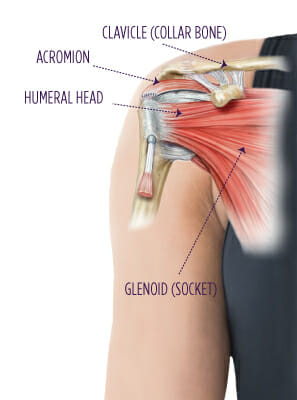What is Arthritis of the shoulder?

In a healthy shoulder, flexible connective tissue called cartilage coats the end of these bones and a thick liquid lubricates it. This allows for smooth, normal movement. In the arthritic joint, the cartilage has worn away and the joint surface has become rough and irregular. This prevents the joint from moving correctly. As the cartilage wears down, bone on bone rubbing occurs. This results in further damage, increased pain and bone spurs.
The shoulder joint is composed of several bones; the humeral head (ball) and the glenoid (socket) make up the ball and socket part of the shoulder. The acromion (top of the shoulder blade) and clavicle (collar bone) make up the top of the shoulder. Arthritis can occur in both the ball and socket joint as well as the AC joint (space between the acromion and clavicle). Arthritis can be caused by many factors including prior injury, genetics, some diseases such as rheumatoid arthritis, and excessive weight.
What are the symptoms?
- Pain and Swelling
- Clicking or grinding sensations
- Decreased ability to move the joint
How did my doctor diagnose it?
Arthritis is typically diagnosed by an X-ray and physical examination. Sometimes an MRI can be helpful as well.
Treatment Options
- Anti-Inflammatory Medication: Over the counter medications such as Aleve, Advil, Motrin, and aspirin can be used to help reduce swelling and pain.
- Activity Modification: Some arthritis symptoms can be relieved by avoiding activities that make your symptoms worse.
- Wellness: Start with a free wellness consult to explore your goals and what tools are available to you.
- integrated physical therapy and wellness: Our team of physical therapists, performance specialists, and registered dietitians works collaboratively with you in designing an integrated rehabilitation plan that will help you reach your full potential.
- Physical Therapy: Physical Therapists treat conditions with a variety of techniques, home exercises may also be provided.
- Injections: A cost effective alternative to surgery. A medication is injected directly into the inflamed joint in the physician’s office.
- Surgery: In some cases surgery is the most effective treatment. Depending on the nature of your condition, your specialist can recommend an appropriate procedure.
